As humans, we constantly seek ways to connect with our inner selves and unleash our full potential. Kundalini awakening, a process of spiritual awakening, has gained immense popularity over the years due to its transformative effects. This process involves the awakening of the dormant energy within us, known as the Kundalini, which travels through the chakras and brings about a profound shift in our consciousness. Meditation and yoga have been seen as crucial tools in facilitating this process. In this article, we will delve deep into the role of meditation and yoga in Kundalini awakening and explore the benefits, challenges, and common mistakes to avoid along the way.
Understanding Kundalini Awakening
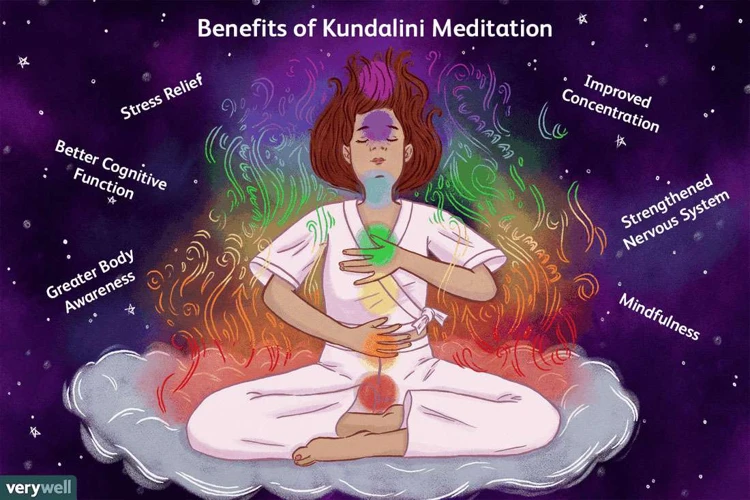
The phenomenon of Kundalini awakening is a complex and intricate process, often shrouded in mystery and limited to esoteric knowledge. It involves the awakening of the energy that lies dormant at the base of the spine, and its ascent through the chakras. The journey of Kundalini awakening is unique to each individual and can bring about profound transformations in all aspects of one’s being. In this section, we will delve deeper into the understanding of Kundalini energy and explore the intricacies of Kundalini awakening.
What is Kundalini?
Kundalini is a Sanskrit term that refers to the energy or life force that exists within every human being. This energy is said to be coiled up at the base of the spine, in the root chakra. When it is awakened, it rises up through the chakras, purifying and energizing them as it goes, until it reaches the crown chakra, facilitating a profound spiritual awakening.
The term Kundalini is derived from a word meaning “coiled up” or “twisted,” which is an apt description of its resting state. The process of Kundalini awakening involves the gradual uncoiling of this energy, leading to a higher state of consciousness and a deep sense of connection with the universe.
Kundalini is often depicted as a serpent, coiled at the base of the spine, waiting to be awakened. When it is activated, it rises up through the chakras, bringing with it a powerful surge of energy that can be both exhilarating and overwhelming.
The awakening of Kundalini is said to be a transformative experience, leading to higher states of consciousness, spiritual growth, and enlightenment. However, it is important to note that Kundalini awakening can also be accompanied by physical and emotional challenges, particularly for those who are not adequately prepared.
Some common signs of Kundalini awakening include intense physical sensations, such as heat or tingling, as well as intense emotional experiences, such as feelings of love, joy, or peace. As the energy moves through the chakras, it may also trigger memories, feelings, and emotions that have been long suppressed, leading to a powerful process of emotional healing and release.
Kundalini is a powerful force that can help facilitate profound spiritual growth and transformation. However, it is important to approach this process with respect and caution, and to work with a qualified teacher or guide who can provide guidance and support throughout the journey.
Understanding Kundalini Awakening
To truly understand Kundalini Awakening, one must first understand what Kundalini is. Kundalini is described as a powerful energy that is coiled up like a serpent at the base of the spine. When awakened, this energy rises up through the chakras and brings about a range of mind-body-spirit experiences.
Kundalini Awakening is a spiritual practice that aims to unleash this coiled energy and promote spiritual growth and transformation. It is important to note that this practice should be approached with caution and under the guidance of an experienced practitioner or teacher.
During Kundalini Awakening, the practitioner may experience a range of physical, emotional and mental sensations, including intense heat or cold, vibrations, emotional release, and moments of clarity or insight. These experiences can be overwhelming, and proper preparation and guidance should be sought.
The goal of Kundalini Awakening is to achieve a state of higher consciousness, self-realization, and spiritual enlightenment. It is an intense and transformative journey that requires dedication, patience, and a strong commitment to one’s spiritual growth.
Below is a table summarizing the key points of Understanding Kundalini Awakening:
| Concept | Description |
|---|---|
| Kundalini | A powerful energy coiled at the base of the spine |
| Kundalini Awakening | A spiritual practice that aims to unleash this energy and promote spiritual growth and transformation |
| Experiences | During Kundalini Awakening, the practitioner may experience a range of physical, emotional and mental sensations |
| Goal | To achieve a state of higher consciousness, self-realization, and spiritual enlightenment |
| Preparation | Proper preparation and guidance should be sought before undergoing Kundalini Awakening |
The Power of Meditation in Awakening Kundalini
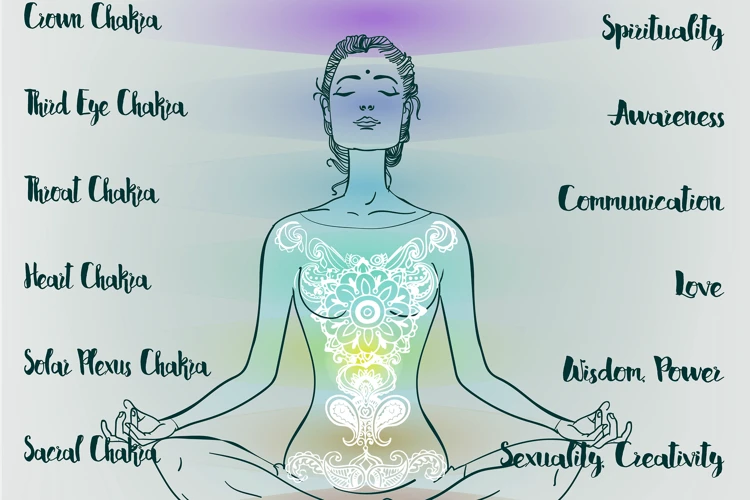
Meditation is a powerful practice that has been used for centuries to achieve inner peace, clarity of mind, and spiritual awakening. It offers a way to connect with our true selves and access deeper levels of consciousness. For those seeking to awaken their Kundalini energy, meditation can be an invaluable tool. Through various meditation techniques and practices, one can facilitate the smooth flow of energy through the chakras, promoting the awakening of the Kundalini. In this section, we will explore the power of meditation in the process of Kundalini awakening, as well as the benefits and practices that can aid in this transformative journey.
What is Meditation?
Meditation is a practice that involves training the mind to focus and be still. It is an ancient technique that has been used for thousands of years as a means to achieve greater levels of awareness and to connect with a higher power.
The following are some of the benefits of meditation:
- Reduces stress and anxiety
- Improves mental clarity and focus
- Helps to develop self-awareness and introspection
- Boosts creativity and enhances problem-solving abilities
- Increases feelings of happiness and well-being
Meditation is a powerful tool that can also facilitate kundalini awakening. Regular meditation practice can help to calm the mind and open up the chakras, which are the energy centers that run along the spine.
Some practices that can be helpful for kundalini awakening:
- Chanting mantras
- Visualizing the flow of energy
- Focusing on the breath
- Practicing mindfulness meditation
It is important to note that there is no one-size-fits-all approach to meditation. Different techniques and practices might work better for different people, and it is essential to find what resonates with you.
The Benefits of Meditation on Kundalini Awakening
Meditation has numerous benefits on Kundalini awakening. Here are some of the most important:
- Helps in regulating the breath: Meditation helps in regulating the breath, which is crucial for the proper flow of energy through the body. When the breath is shallow and irregular, the flow of energy is obstructed, which can lead to blockages in the chakras. By practicing deep, conscious breathing during meditation, you enable the smooth flow of Prana, or life force energy, through the Nadis or energy channels, which in turn facilitates Kundalini awakening.
- Relaxes the body and mind: One of the most observable benefits of meditation is its ability to relax the body and clear the mind of distracting thoughts. This is crucial for Kundalini awakening, as the process can be intense and even overwhelming at times. By regularly meditating, you develop the mental discipline to observe your thoughts without reacting to them, which can help you stay calm and centered during the awakening process.
- Purifies the mind and body: Meditation has been shown to have a purifying effect on the mind and body. Regular practice helps to clear negative emotions and thought patterns, and to release physical and emotional tension from the body. A purified mind and body are better equipped to handle the intense energy releases and transformative experiences that often come with Kundalini awakening.
- Strengthens the nervous system: Kundalini awakening can put a lot of pressure on the nervous system, and if the nervous system is weak, it can lead to physical and mental health problems. Meditation has been shown to strengthen the nervous system and improve its function, which can help prevent these issues from arising.
- Develops spiritual insight: Meditation is a powerful tool for developing spiritual insight and awareness. Regular practice can help you connect with your inner self and gain a deeper understanding of your true nature. This is an essential foundation for Kundalini awakening, as it helps you to stay grounded and connected to your spiritual purpose throughout the journey.
Regular meditation practice can be immensely helpful for preparing the mind and body for the process of Kundalini awakening. It helps to regulate the breath, relax the body and mind, purify negative energies, strengthen the nervous system, and develop spiritual insight.
Practices for Kundalini Awakening
Practices for Kundalini Awakening
There are various practices that can help facilitate Kundalini awakening. Here are some of the most effective ones:
| Practice | Description |
|---|---|
| Kundalini Yoga | A type of yoga that focuses on awakening and channeling the Kundalini energy through the body’s chakras. It includes physical postures, breathing techniques, and meditation. |
| Meditation | One of the most powerful practices for Kundalini awakening. It can help quiet the mind, increase self-awareness, and activate the flow of Kundalini energy upwards. |
| Pranayama | A set of breathing exercises that can help regulate the flow of energy in the body and stimulate the awakening of Kundalini. |
| Mantra chanting | Repeating a specific word or phrase, known as a mantra, can help focus the mind and activate the chakras, leading to the awakening of Kundalini. |
| Tantric practices | These practices involve the use of specific physical postures (asanas), breathing techniques, and meditation to activate Kundalini and channel the energy through the body’s chakras. |
| Visualization | The use of mental imagery can help activate and channel the Kundalini energy through the body’s chakras. |
It’s important to note that while these practices can be helpful for Kundalini awakening, they should be done under the guidance of a qualified teacher. It’s also important to approach Kundalini awakening with patience, respect, and a readiness to face any challenges that may arise. With dedication and mindfulness, the transformative journey of Kundalini awakening can be a truly life-changing experience.
The Role of Yoga in Kundalini Awakening

As we continue to explore the various practices that can facilitate Kundalini awakening, one technique that has been widely recognized is yoga. Originating from ancient India, yoga comprises a combination of physical postures, breathing exercises, and meditation. Its ability to unlock the energy within us and facilitate the flow of prana is critical in awakening the Kundalini. In this section, we will delve into what yoga is, its benefits in Kundalini awakening, and the different types of yoga practices that can be incorporated into our Kundalini awakening journey.
What is Yoga?
Yoga is a physical, mental, and spiritual practice that originated in ancient India. It is a holistic practice that aims to unify the mind, body, and soul. The word ‘yoga’ comes from the Sanskrit word ‘yuj’, which means ‘to unite’. Yoga is an excellent way to promote overall well-being and achieve a state of inner balance and harmony.
The benefits of yoga are many:
- Physical benefits: Regular practice of yoga asanas (postures) can improve flexibility, strength, posture, balance, and coordination. It can also help in weight management and improve respiratory and cardiovascular health.
- Mental benefits: Yoga is an excellent way to reduce stress and anxiety. It can improve mental clarity, concentration, and focus. Regular practice of yoga can also help in enhancing self-awareness and mindfulness.
- Spiritual benefits: Yoga is a spiritual practice that can help us connect with our inner selves. It can lead to a sense of inner peace, contentment, and spiritual growth.
Types of yoga for Kundalini awakening:
- Hatha yoga: This is the most popular form of yoga that involves physical postures, breathing exercises, and meditation. It is an excellent practice for beginners and can help in preparing the body for Kundalini awakening.
- Kundalini yoga: As the name suggests, this form of yoga is specifically designed to awaken the Kundalini energy. It involves dynamic movements, breathing exercises, chanting, and meditation.
- Raja yoga: This is also known as ‘royal yoga’ and involves the practice of meditation and spiritual self-discipline.
- Bhakti yoga: This is the path of devotion and involves the practice of devotion to a chosen deity or guru.
- Jnana yoga: This involves the practice of self-inquiry and introspection. It aims to cultivate wisdom and knowledge through the study of scriptures and contemplation.
Yoga is an excellent practice to incorporate into your daily routine to promote overall well-being and facilitate Kundalini awakening. Various forms of yoga can be practiced depending on your personal preference and level of experience. With regular practice, yoga can help you connect with your inner self and experience a profound sense of spiritual growth.
Benefits of Yoga on Kundalini awakening
Yoga is a multifaceted practice that has been used for centuries to achieve spiritual and physical wellbeing. When it comes to awakening Kundalini energy, yoga can be a powerful tool. Here are some of the benefits of yoga on Kundalini awakening:
| Benefit | Description |
|---|---|
| Clearing and balancing the chakras | Yoga postures, or asanas, are designed to stimulate and balance the flow of energy through the chakras, which can help to awaken Kundalini energy and facilitate its ascent through the central channel. |
| Activating the energy body | The practice of yoga involves not just physical postures, but also pranayama or breathing exercises and meditation, which can help to activate and awaken the energy body, including the Kundalini. |
| Strengthening the nervous system | The Kundalini energy can be intense and overwhelming, but regular yoga practice can help to build resilience in the nervous system, allowing practitioners to better handle the energy and its effects. |
| Promoting relaxation and stillness | The practice of yoga can help to promote a state of relaxation and stillness, which can be beneficial for Kundalini awakening. When the mind and body are calm and focused, the energy is more likely to flow freely and naturally. |
| Facilitating surrender and release | One of the keys to successful Kundalini awakening is surrendering to the process and allowing the energy to flow in its own time and way. The practice of yoga can help to cultivate this sense of surrender and release, allowing the energy to move more smoothly. |
The practice of yoga can be an excellent complement to meditation and other practices for awakening Kundalini energy. By balancing the chakras, activating the energy body, strengthening the nervous system, promoting relaxation and stillness, and facilitating surrender and release, yoga can help practitioners to prepare for and navigate the transformative journey of Kundalini awakening.
Types of Yoga for Kundalini Awakening
Yoga is a powerful practice that can help awaken Kundalini energy. There are various types of yoga that can be practiced for this purpose. Here are some of the most effective types of yoga for Kundalini Awakening:
- Kundalini Yoga: This specific type of yoga is designed to awaken Kundalini energy. It involves a combination of physical postures, breathing techniques, and mantras.
- Hatha Yoga: This is one of the most popular types of yoga practiced around the world. Hatha yoga involves a series of physical postures (asanas) and breathing techniques (pranayama). It is known to help calm the mind and prepare the body for meditation, which can facilitate Kundalini Awakening.
- Bhakti Yoga: This type of yoga is centered around devotion and love towards a higher power. It involves chanting, prayer, and singing. Practicing Bhakti yoga can help deepen one’s spiritual connection and open the heart chakra, which is crucial for Kundalini Awakening.
- Jnana Yoga: This type of yoga is focused on self-inquiry and wisdom. It involves studying spiritual texts and reflecting on their meaning. Practicing Jnana yoga can help one understand the nature of oneself and reality, which is essential for Kundalini Awakening.
- Raja Yoga: This type of yoga is also known as the “Royal Path” of yoga. It involves a combination of physical postures, breathing techniques, and meditation. Practicing Raja Yoga can help one achieve a state of mental stillness and inner peace, which is crucial for Kundalini Awakening.
It’s important to note that practicing any type of yoga with intention and mindfulness can be helpful for Kundalini Awakening. It’s best to choose the type of yoga that resonates with your personal beliefs and preferences, and to practice consistently over time. Consistency and dedication are key to experiencing the benefits of yoga on Kundalini Awakening.
Chakras and their Role in Kundalini Awakening
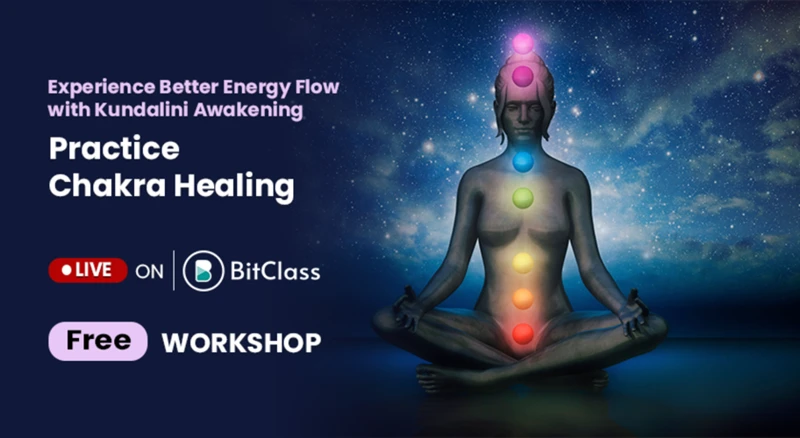
As we explore the depths of Kundalini awakening, we come across the pivotal role of the chakras in this transformative journey. These energy centers within our bodies hold immense power and potential, and play a crucial role in the awakening process. While many may have heard of chakras before, the intricate connection between chakras and Kundalini may still leave some perplexed. However, a deeper understanding of the chakras and their influence on Kundalini awakening can greatly aid in navigating this profound experience. Let us dive into the intricacies of the chakra system and its role in our Kundalini journey.
Understanding the Chakras
The concept of chakras is an essential aspect of Kundalini awakening. Understanding the chakras can help individuals to have a clear understanding of the energy centers of the body. There are seven major chakras in the body, and each of them plays a vital role in our physical, emotional, and spiritual well-being.
1. Root Chakra: This chakra is located at the base of the spine, and it is associated with inner strength, stability, and security.
2. Sacral Chakra: The sacral chakra is located just below the navel, and it is associated with creativity, sexuality, and passion.
3. Solar Plexus Chakra: This chakra is located just above the navel, and it is associated with personal power, will, and autonomy.
4. Heart Chakra: The heart chakra is located in the center of the chest, and it is associated with love, connection, and compassion.
5. Throat Chakra: This chakra is located at the base of the throat, and it is associated with communication, self-expression, and authenticity.
6. Third Eye Chakra: The third eye chakra is located in the center of the forehead, and it is associated with intuition, insight, and wisdom.
7. Crown Chakra: This chakra is located at the top of the head, and it is associated with spiritual connection, enlightenment, and transcendence.
Each of these chakras is associated with specific colors, elements, and emotions, which can be used to identify any blockages or imbalances in their respective energy centers. By understanding the chakras and their corresponding qualities, individuals can work to balance and harmonize their energy centers, facilitating the awakening of Kundalini energy.
It is essential to note that the chakras do not exist in isolation but are interconnected and interact with one another. This interaction can be seen as a flow of energy up and down the body known as the “Prana” or the life force energy. When the chakras are in balance, the flow of Prana is harmonious, resulting in physical, emotional, and spiritual well-being.
How chakras affect Kundalini Awakening
The chakras play a significant role in Kundalini Awakening. There are seven chakras or energy centers in the human body, and each one corresponds to a specific part of the body, emotion, and spiritual aspect. When Kundalini energy rises, it passes through each chakra, activating and cleansing them, and ultimately leading to spiritual enlightenment.
Chakra | Location | Emotion | Spiritual Aspect
— | — | — | —
Root Chakra | Base of the spine | Survival, security, grounding | Foundation of physical existence
Sacral Chakra | Lower abdomen | Creativity, sexuality, pleasure | Intention and desire
Solar Plexus Chakra | Upper abdomen | Personal power, confidence | Ego and identity
Heart Chakra | Center of the chest | Love, compassion | Connection to self and others
Throat Chakra | Throat | Communication, self-expression | Inner truth and understanding
Third Eye Chakra | Between the eyes | Intuition, clarity, perception | Perception and insight
Crown Chakra | Top of the head | Spiritual consciousness, oneness | Connection to the divine
The awakening of Kundalini energy begins at the root chakra and moves up through the other six chakras. Each chakra is associated with a unique spiritual aspect that is essential to the awakening process. For example, the heart chakra is associated with love and compassion, which are necessary for opening oneself up to the divine and connecting with others.
When the Kundalini energy reaches the third eye chakra, it opens up the door to higher states of consciousness, such as enlightenment. The crown chakra, which is located at the top of the head, is associated with oneness and a connection to the divine, which is the ultimate goal of Kundalini Awakening.
It is important to note that the awakening of Kundalini energy can be dangerous if it is not done correctly. Suppose there are blockages in any of the chakras or the energy centers are imbalanced. In that case, it could lead to physical, emotional, or mental problems. It is crucial to work on and balance each chakra before attempting Kundalini Awakening.
Preparing for Kundalini Awakening
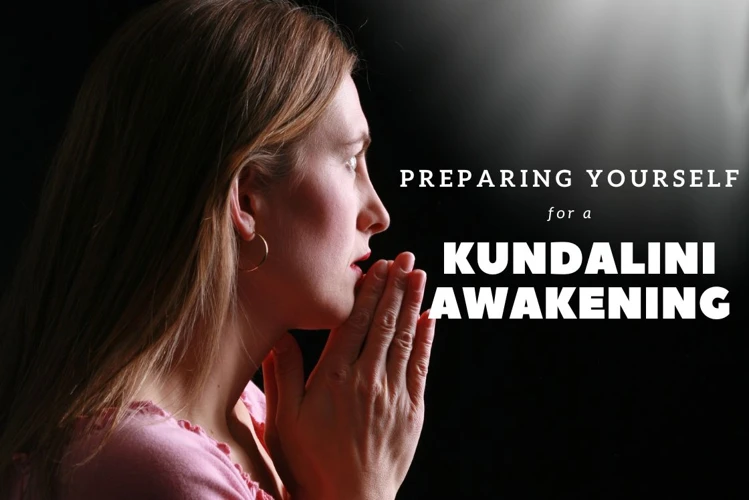
Preparing yourself for the experience of Kundalini Awakening can be a perplexing and challenging journey. It’s essential to take physical and mental preparation seriously to ensure that you’re ready for the powerful energy that can come with it. In this section, we’ll explore the importance of being adequately prepared for Kundalini Awakening and provide helpful tips for a successful and safe journey. So let’s delve into what you need to know to get ready for this transformative experience.
The importance of physical and mental preparation
Preparing for Kundalini awakening is a crucial step towards a successful journey. Physical and mental preparation both play a significant role in Kundalini awakening. Physical preparation involves taking care of your body by adopting a healthy lifestyle. Mental preparation involves being mindful of your thoughts and emotions.
The following table lists some key aspects of physical and mental preparation for Kundalini awakening:
| Physical Preparation | Mental Preparation |
|---|---|
| Regular exercise | Developing mindfulness |
| Healthy eating habits | Cultivating a positive outlook |
| Maintaining a consistent sleep schedule | Learning to manage stress |
| Staying hydrated | Practicing gratitude and compassion |
| Avoiding intoxicating substances | Being open to change |
Physical preparation involves taking care of your body by adopting a healthy lifestyle. Exercising regularly, maintaining a consistent sleep schedule, staying hydrated, having healthy eating habits and avoiding intoxicating substances are important factors in physical preparation. These habits help to enhance your physical health, thereby making you better equipped to handle the intense experiences of Kundalini awakening.
Mental preparation involves developing mindfulness, cultivating a positive outlook, learning to manage stress, practicing gratitude and compassion, and being open to change. These factors help in mental preparation for Kundalini awakening. Mindfulness helps you to be aware of your thoughts and emotions, which aids in managing stress. A positive outlook and being open to change are also important in this journey, as they help you to remain resilient during tough times.
Paying attention to both physical and mental preparation is essential before embarking on the journey of Kundalini awakening. It is important to remember that this journey can be a challenging one, but with proper preparation, one can navigate it successfully.
Tips for successful Kundalini Awakening
When embarking on a journey of Kundalini awakening, it is important to keep a few tips in mind to make the process successful and smooth. Below are some tips that can help in achieving a successful Kundalini awakening:
| Tip | Description |
|---|---|
| 1. Consistency is key | Regular practice of meditation and yoga is crucial for Kundalini awakening. It is important to dedicate a set time each day for practice and stick to it. |
| 2. Be patient | Kundalini awakening is a gradual process that requires time, effort and patience. It is important to trust the process and not rush through it. |
| 3. Take care of the physical body | A healthy physical body is necessary for the smooth flow of Kundalini energy. Eating a balanced diet, getting enough rest and staying active can help maintain a healthy body. |
| 4. Practice self-awareness | Self-awareness is key in Kundalini awakening. It is important to be aware of one’s thoughts, feelings, and actions to facilitate the release of blocked energy. |
| 5. Seek guidance when needed | Kundalini awakening can be an intense experience, and it is important to seek guidance from a teacher or mentor who has experience in the practice. |
| 6. Be open to the experience | Kundalini awakening can bring about a range of experiences and emotions. It is important to approach them with an open and accepting mindset to fully embrace the transformative journey. |
By keeping these tips in mind, individuals can ensure a successful Kundalini awakening experience.
Recognizing the Signs of Kundalini Awakening
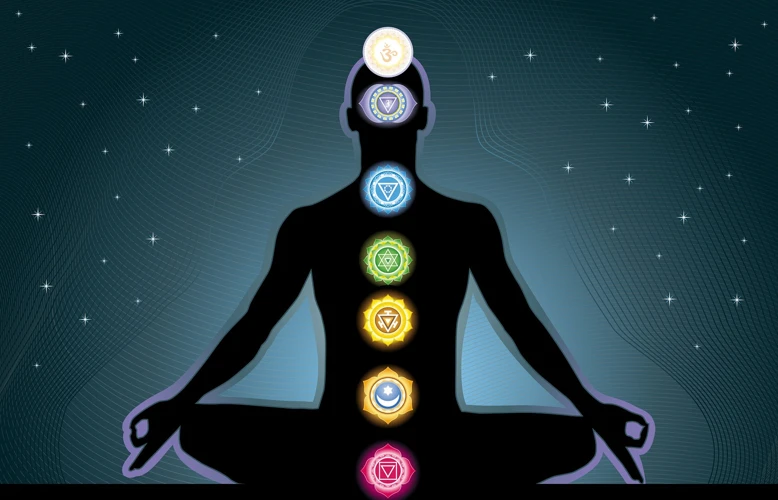
As you immerse yourself in meditation and yoga practices with the goal of awakening your Kundalini energy, it is essential to be aware of the signs that indicate progress is being made. These signs can manifest physically, emotionally, and mentally, and it is vital to recognize them to remain focused and motivated on your transformative journey. In this section, we will explore the various signs to look out for and what they mean on the path to Kundalini awakening.
The Physical, Emotional and Mental signs of Kundalini Awakening
Kundalini Awakening is a transformative journey that can impact an individual in various aspects of their life. The signs of Kundalini Awakening can manifest itself in different ways, including physical, emotional, and mental aspects of an individual’s body and mind. Here are some of the signs to look out for:
Physical Signs:
- Feeling intense energy and heat in your body.
- Tingling sensations throughout your body.
- Spontaneous movements or spontaneous energy release throughout your body.
- Feeling a heavy weight on top of you or as if you are floating.
- Visions or seeing bright lights, colors or images.
Emotional Signs:
- Experiencing intense emotions, ranging from joy to fear, without apparent reason.
- Feeling a profound sense of connection and oneness with everything around you.
- Overwhelming feelings of love, compassion, and empathy for others.
- Feeling a sense of detachment from the material world, attachment to relationships, and a desire for solitude.
Mental Signs:
- Experiencing a heightened sense of clarity and focus.
- Enhanced creativity and intuition.
- Deep insights into the true nature of reality and a desire for self-discovery.
- Experiencing a sense of merging with the divine, leading to feelings of deep peace and fulfillment.
It is important to note that these signs may not occur in any particular order and may differ from person to person. If you are experiencing any of these signs or are going through Kundalini Awakening, it is important to seek guidance from a trained professional or a mentor who has undergone the process.
Overcoming the Challenges of Kundalini Awakening

As with any transformative journey, the process of Kundalini Awakening can come with unexpected challenges. The intense energy shifts and heightened awareness can bring up unresolved emotions and deeply ingrained patterns. It is crucial to be aware of these potential obstacles and to have a plan in place to overcome them. In this section, we will explore the common challenges experienced during Kundalini Awakening and provide tips on how to overcome them. Let’s dive in and discover how to navigate this transformative process with self-awareness and grace.
Common Challenges of Kundalini Awakening
As with any spiritual journey, Kundalini Awakening is not without its challenges. It can be a transformative and powerful experience, but it can also bring about some difficulties that require patience and dedication to overcome.
Here are some common challenges that individuals may face during their Kundalini Awakening:
- Physical discomfort: During the process of Kundalini Awakening, individuals may experience physical discomfort such as muscle twitching, cramping, or tightness. It is important to listen to your body and give it the rest and care it needs.
- Emotional upheaval: The release of repressed emotions can be overwhelming and may bring about feelings of sadness, anger, or fear. This can be a difficult period of adjustment, but it is important to stay present and allow these emotions to pass through you.
- Mental confusion: Kundalini Awakening can also bring about mental confusion and a sense of being lost. It is important to stay grounded and seek support from a trusted friend or practitioner to help navigate these feelings.
- Difficulty with daily life: As Kundalini Awakening brings about significant changes, it may create challenges in daily life such as difficulty with work or social relationships. It is important to stay patient and focus on self-care during this time of growth.
- Physical sensitivity: As the Kundalini energy moves through the body, individuals may become highly sensitive to loud noises, bright lights, or strong smells. It is important to honor these sensitivities and create a calm and peaceful environment for yourself.
While these challenges can be daunting, they are all part of the process of Kundalini Awakening and can ultimately lead to growth, healing, and transformation. By staying grounded and seeking support from trusted practitioners or friends, individuals can navigate these challenges and fully embrace the journey of awakening.
Ways to overcome these challenges
Overcoming the challenges that may arise during the Kundalini awakening journey is essential to ensure a smooth and safe journey. Here are some ways to overcome these challenges:
| Challenge | Ways to overcome the challenge |
|---|---|
| Physical discomfort | Practice gentle yoga and deep breathing exercises to relieve physical tension. Seek medical advice if necessary. |
| Emotional turmoil | Seek support from a trusted friend, family member, or therapist. Practice journaling and self-reflection to regulate emotions. |
| Difficulty concentrating | Incorporate mindfulness practices to improve focus and concentration. Reduce distractions and create a peaceful environment for meditation. |
| Unsettling spiritual experiences | Seek guidance from a trusted spiritual teacher or mentor. Practice grounding techniques such as walking in nature and connecting with the earth. |
| Feeling overwhelmed | Take breaks and practice self-care. Remember to pace yourself and prioritize self-compassion. |
| Resistance to change | Practice self-reflection and identify the root cause of resistance. Work on releasing attachment and embracing change through meditation and self-awareness. |
By taking steps to overcome these challenges, individuals can fully embrace and benefit from their Kundalini awakening experience.
Benefits of Kundalini Awakening

The journey of Kundalini awakening is not an easy one, as it involves a deep transformation of the mind, body, and spirit. However, the incredible benefits that come with this awakening are worth the effort and dedication that is required. From spiritual to physical and emotional benefits, the impact of Kundalini awakening can be felt in every aspect of our lives. Let’s delve deeper into the numerous advantages that await those who embark on this transformative journey.
Spiritual Benefits
Kundalini awakening is a journey towards spiritual growth and transformation. The spiritual benefits of Kundalini awakening are profound and can be life-changing for many people. Here are some of the spiritual benefits you may experience during Kundalini awakening:
- Connections to the Divine: Kundalini awakening can help you connect to a higher power or the divine consciousness. It can provide you with a deeper sense of purpose and meaning in life.
- Heightened Awareness and Intuition: During Kundalini awakening, you may experience a heightened sense of awareness and intuition. This can help you better understand and navigate the world around you.
- Inner Peace and Calm: Kundalini awakening can bring a sense of inner peace and calm that can help you better cope with stress and anxiety.
- Self-Realization and Self-Awareness: Kundalini awakening can help you better understand yourself and your place in the world. It can bring clarity and focus to your life’s purpose and help you move towards self-realization.
- Connection to Others: Kundalini awakening can also help you deepen your connections with others. You may feel a sense of oneness with those around you, which can promote greater empathy and understanding.
- Spiritual Growth and Evolution: Kundalini awakening is a transformative journey towards spiritual growth and evolution. It can help you unlock your full potential and tap into your innate wisdom and creativity.
These spiritual benefits may not manifest immediately during Kundalini awakening, and the journey towards spiritual growth can require patience, persistence, and dedication to the practice of meditation and yoga. However, for those who are committed to the journey, the spiritual benefits can be life-changing and deeply rewarding.
Physical Benefits
When Kundalini energy is awakened, it can bring about a range of physical benefits. Let’s take a look at some of these benefits in detail:
| Physical Benefits of Kundalini Awakening |
|---|
| Improved physical health |
| The activation of Kundalini energy can enhance the functioning of the entire body, leading to a stronger immune system and better overall health. |
| Increased energy levels |
| Kundalini awakening can increase the amount of energy flowing through the body, leading to better energy levels and decreased levels of fatigue and exhaustion. |
| Relief from physical pain |
| Kundalini awakening can help relieve physical pain in the body by releasing tension and promoting relaxation. |
| Better sleep |
| Kundalini awakening can lead to better sleep by calming the mind and body, and helping to alleviate stress and anxiety. |
| Increased flexibility and strength |
| Yoga, which is often used as a tool for Kundalini awakening, can lead to increased flexibility and strength in the body. |
| Improved digestive function |
| Kundalini awakening can help regulate the digestive system, leading to improved functioning and better overall health. |
| Reduced physical tension |
| Through practices like meditation and yoga, Kundalini awakening can help release physical tension in the muscles and joints, leading to greater relaxation and a sense of ease in the body. |
While these physical benefits are certainly notable, it’s important to remember that Kundalini awakening also has a profound impact on the spiritual and emotional aspects of our being. By working to unlock this powerful energy, we can open ourselves up to a wealth of transformative experiences and growth opportunities.
Emotional Benefits
When talking about Kundalini Awakening, it is important to highlight the emotional benefits one can experience. Kundalini Awakening can lead to a range of emotional benefits, as it allows individuals to tap into their deeper emotions and connect with their inner self.
Below are some of the emotional benefits that one can experience from Kundalini Awakening:
| Emotional Benefits of Kundalini Awakening |
|---|
| Increased self-awareness: Kundalini Awakening can lead to a heightened sense of self-awareness. One becomes more aware of their thoughts, emotions, and actions, and can identify patterns and change them if needed. This can help individuals develop a more positive and healthy mindset. |
| Better emotional regulation: Kundalini Awakening can also help individuals regulate their emotions better. They can identify their triggers and handle difficult situations with ease. This leads to a more peaceful and content state of mind. |
| Increased empathy: Another emotional benefit of Kundalini Awakening is the increase in empathy towards others. One can understand and relate to others on a deeper level, build stronger relationships and foster a sense of community. |
| Release of suppressed emotions: Often, individuals tend to suppress their negative emotions, which can lead to pent-up stress and anxiety. Kundalini Awakening can help release these suppressed emotions, allowing individuals to acknowledge and deal with them in a healthy manner. |
| Greater sense of purpose: Kundalini Awakening can also lead to a greater sense of purpose in life. One can identify their true passions and goals, and work towards achieving them with renewed focus and energy. |
It is important to note that Kundalini Awakening is a gradual process, and emotional benefits can take some time to fully manifest. However, with consistent practice and patience, one can experience a range of emotional benefits that can positively impact their overall well-being.
Mistakes to Avoid in Kundalini Awakening
As with any transformative journey, Kundalini awakening has its fair share of challenges and pitfalls. However, by avoiding common mistakes, one can ensure a smoother and more fulfilling experience. In this section, we will explore the usual stumbling blocks that people face during Kundalini awakening and provide tips to help you avoid them. By heeding these warnings, you can create a safe and nurturing environment for your awakening process and enjoy the full benefits that Kundalini has to offer.
Common Mistakes
Many people are drawn to the idea of Kundalini Awakening and the potential for spiritual growth and transformation that comes with it. However, there are common mistakes that beginners make on this journey that can hinder their progress and even cause harm.
1. Rushing the Process: One of the biggest mistakes people make is rushing the process. Kundalini Awakening is a transformative journey that requires patience and dedication. Attempting to force the process or expecting quick results can lead to disappointment and even physical or emotional harm.
2. Neglecting Physical Health: Neglecting physical health and wellness can also hinder Kundalini Awakening. The body and mind are deeply connected, and neglecting one can affect the other. It is essential to maintain a healthy diet, engage in regular exercise, and get sufficient rest to support the body and mind during this transformative process.
3. Ignoring the Importance of a Qualified Teacher: Another common mistake is ignoring the importance of a qualified teacher. Kundalini Awakening is a complex and powerful process that should not be undertaken without proper guidance. A qualified teacher can help individuals navigate the challenges and ensure they are progressing safely and effectively.
4. Becoming Obsessed with Results: Becoming obsessed with results can also hinder progress. While it is natural to want to see progress and transformation, becoming overly fixated on the outcome can lead to frustration and anxiety, making it difficult to stay present in the moment and practice effectively.
5. Neglecting Self-Care: Finally, neglecting self-care can also hinder progress. Taking care of oneself physically, emotionally, and spiritually is crucial during the Kundalini Awakening process. Neglecting self-care can lead to physical or emotional burnout and hinder progress on this transformative journey.
Avoiding these common mistakes and approaching Kundalini Awakening with patience, dedication, and proper guidance can lead to a transformative and life-changing experience.
How to avoid them
Avoiding common mistakes during Kundalini Awakening is crucial for a safe and transformative experience. Here are some tips to avoid these mistakes:
| Mistake | How to Avoid |
| Not seeking guidance | It’s important to seek guidance from an experienced practitioner or teacher who has gone through the Kundalini Awakening process themselves. They can provide support and guidance to help you navigate the journey. |
| Rushing the process | Kundalini Awakening is a gradual process, and attempting to rush it can cause harm. Listen to your body and take the process one step at a time. |
| Ignoring physical, mental, or emotional signs | It’s important to pay attention to the physical, mental, and emotional signs during Kundalini Awakening. Ignoring these signs can cause harm or lead to an unfulfilling experience. |
| Losing connection with reality | Kundalini Awakening can be a powerful experience, but it’s important to maintain a connection with reality. Avoid becoming too detached from everyday life and maintain a balance between spiritual growth and practical living. |
| Forcing the process | Kundalini Awakening is a natural process that cannot be forced. Attempting to force the process can cause harm or lead to an unfulfilling experience. Allow the process to unfold naturally and trust in its timing. |
By following these tips, individuals can have a more safe and fulfilling experience during Kundalini Awakening. It’s important to approach the process with intention, care, and guidance to fully reap the benefits of this transformative journey.
Conclusion
As we come to the end of this extensive exploration of the role of meditation and yoga in facilitating Kundalini awakening, one thing is certain – the transformative potential of this spiritual journey is profound. From understanding the subtle energy centers within the body to recognizing the signs and challenges of Kundalini awakening, we have delved deep into the complex and intricate nature of this experience. While there is no one-size-fits-all formula for success, the benefits of this awakening are undeniable. In this final section, we will take a moment to reflect on the journey and the importance of approaching it with mindfulness and intention.
The transformative journey of Kundalini Awakening
Kundalini awakening is a transformative journey of self-discovery and spiritual enlightenment. It involves the activation of the Kundalini energy that lies dormant at the base of the spine, and its ascent through the chakras to unite with the divine consciousness.
During this journey, individuals may experience a range of physical, emotional, and mental sensations, as well as profound spiritual insights and realizations.
The transformative journey of Kundalini awakening can be divided into three stages:
- The Initiation: This stage marks the initial awakening of the Kundalini energy, which can happen spontaneously or through dedicated spiritual practices such as meditation, yoga, or pranayama. Individuals may experience physical symptoms such as tingling sensations, heat, or pressure in the body, as well as vivid dreams, intense emotions, and heightened intuition.
- The Integration: In this stage, the Kundalini energy begins its ascent through the chakras, activating and purifying each one. This can lead to a range of experiences such as visions, altered states of consciousness, and a deepening connection with the divine. However, as the energy rises, individuals may also encounter challenges and blockages that need to be worked through, both on a physical and emotional level.
- The Union: The final stage of the Kundalini awakening journey involves the union of the awakened Kundalini energy with the cosmic consciousness. This can result in a profound sense of oneness and unity with all things, as well as heightened creativity, intuitive abilities, and spiritual insight. This stage is characterized by a deep peace and a sense of divine love and bliss.
It is important to note that the transformative journey of Kundalini awakening is not always smooth or easy. Individuals may encounter challenges such as physical discomfort, emotional turmoil, or a sense of disorientation as they navigate this uncharted territory.
However, with the right support, guidance, and practices, individuals can successfully navigate this transformative journey and reap the many spiritual, physical, and emotional benefits that come with Kundalini awakening.
Frequently Asked Questions
What are the benefits of Kundalini Awakening?
Kundalini Awakening can lead to spiritual growth, enhanced creativity, increased energy, and better physical, mental, and emotional health.
Is Kundalini Awakening dangerous?
It can be if not approached with caution and proper preparation. People with pre-existing mental health conditions should consult a professional before attempting Kundalini Awakening.
What is the role of meditation in Kundalini Awakening?
Meditation is a powerful tool to awaken Kundalini energy. It can calm the mind, increase focus, and open up the chakras, leading to the awakening of Kundalini energy.
What is the role of yoga in Kundalini Awakening?
Yoga can help prepare the body and mind for Kundalini Awakening. It can balance energy, improve flexibility, and increase mindfulness.
What are the physical signs of Kundalini Awakening?
Physical signs of Kundalini Awakening include tingling sensations, heat or coldness, shaking, and involuntary movements.
What are the emotional signs of Kundalini Awakening?
Emotional signs of Kundalini Awakening include mood swings, heightened sensitivity, and feeling overwhelmed or ecstatic.
What are the mental signs of Kundalini Awakening?
Mental signs of Kundalini Awakening include vivid dreams, increased intuition, and heightened creativity.
Can anyone experience Kundalini Awakening?
Yes, anyone can potentially experience Kundalini Awakening, but some people may need more preparation and guidance than others.
What are some common mistakes to avoid during Kundalini Awakening?
Some common mistakes to avoid during Kundalini Awakening include pushing yourself too hard, not seeking guidance, and not taking care of your physical body.
What are some practical tips for successful Kundalini Awakening?
Some practical tips for successful Kundalini Awakening include practicing mindfulness, getting enough sleep and hydration, and seeking guidance from a trusted teacher.








